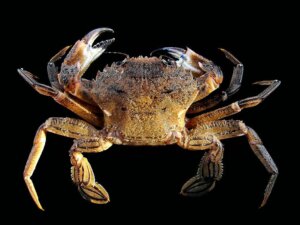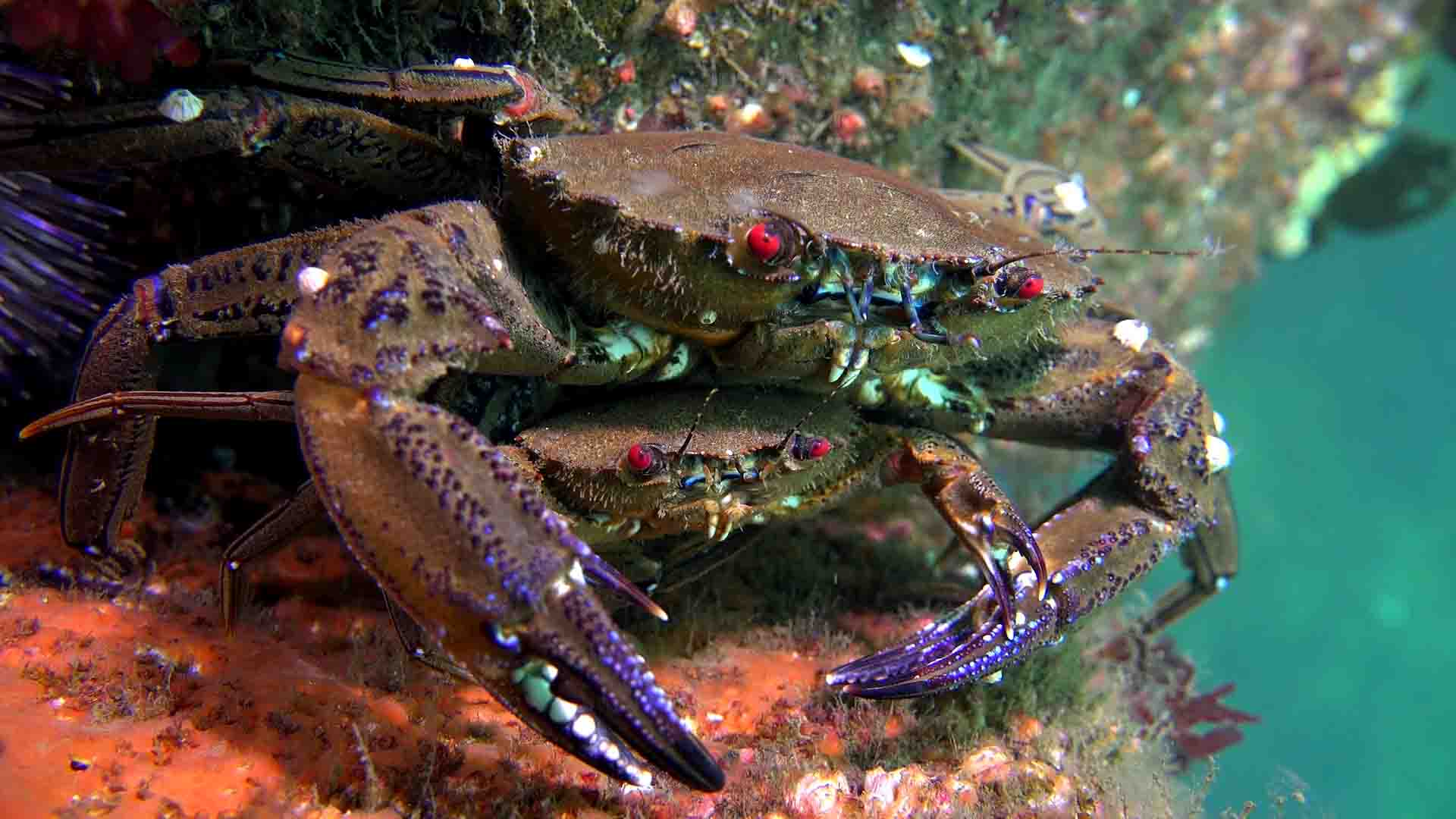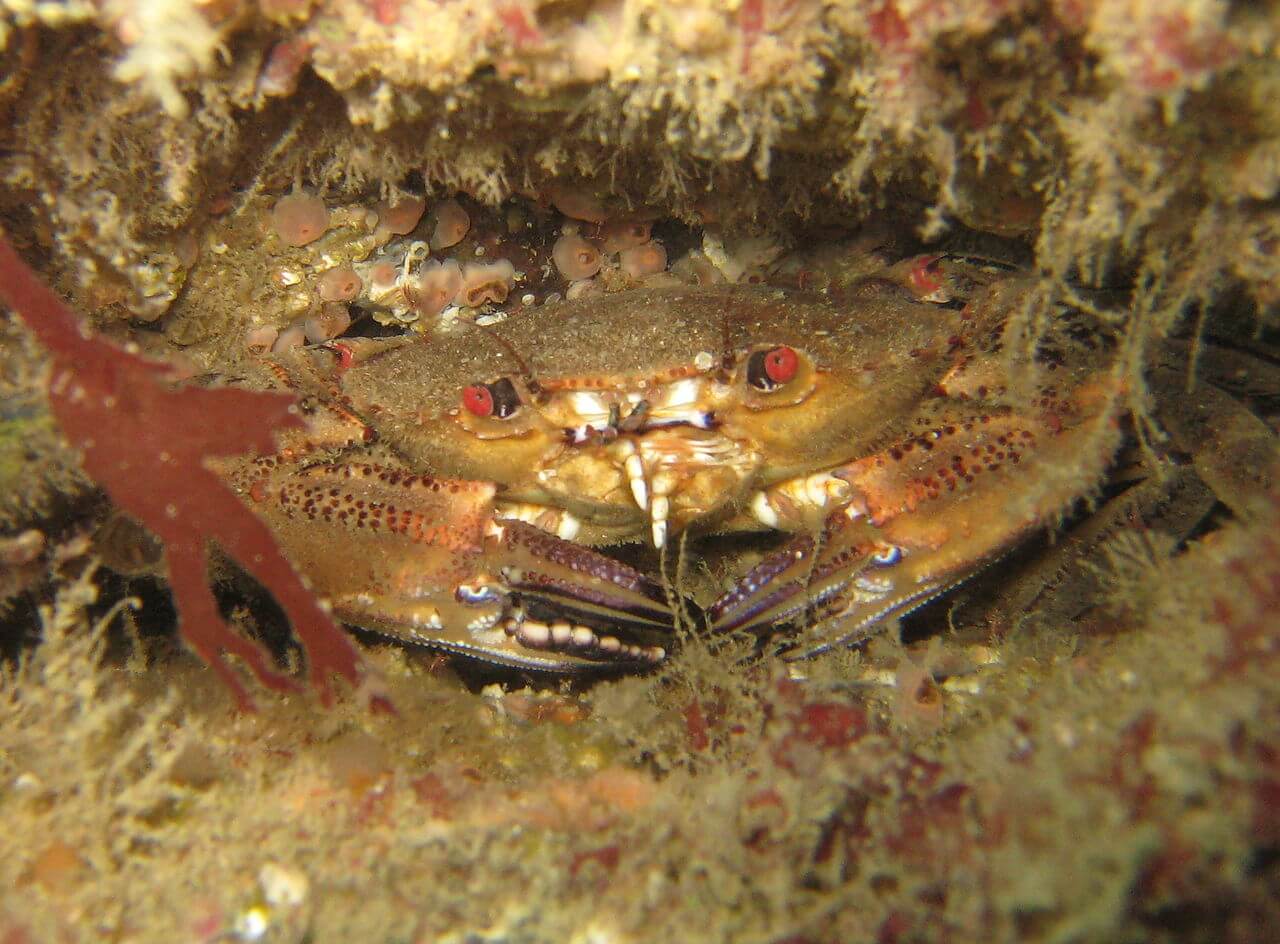7 Curiosities About Velvet Crabs


Written and verified by the veterinarian and zootechnician Sebastian Ramirez Ocampo
Velvet crabs, whose scientific name is Necora puber, are small decapod crustaceans that inhabit the salty waters of the European Atlantic coast. They have an average size of 10 centimeters (4 inches) in adulthood and their coloration is dark brownish. Find out all about this fascinating animal here!
Curious facts about velvet crabs
They have a strong hexagonal shell 4 centimeters long and 5 centimeters wide (1.6 by 2 inches). In addition, they’re covered by numerous hairs, which give them a velvety appearance. They also have two prominent red eyes, adapted to see in the dark, as they are nocturnal.
They also have five pairs of limbs; the first pair has morphologically developed into large, uneven pincers, covered by small granular ridges. Discover some more fascinating aspects about velvet crabs below.
1. Velvet crabs have a clear sexual dimorphism
First of all, the main characteristic that differentiates both sexes is the abdomen. On the one hand, males, which are also larger, have a triangular abdomen, with the third to fifth segments welded together.
On the other hand, the female has a wider and rounder ventral area, which is different in order to carry the eggs during oviposition. Another difference between the sexes is the size of the pincers, which are larger in the male specimens.

2. It’s a swimming crab
While its first two limbs developed into claws suitable for hunting and territorial defense, the last ones evolved into wider, paddle-shaped legs. Thanks to this characteristic, this crab, unlike other crustaceans, can move quickly on the ground and also swim skillfully in the sea.
For this reason, in many parts of Spain, it’s known as the “flying clam”, because its movement in the water gives the sensation of flying. Many other crabs can swim and walk on land, but not all of them.
3. Velvet crabs are very territorial
These crustaceans mainly inhabit sandy, rocky and muddy bottoms at a depth of about 70 meters (230 feet) along the European Atlantic coast. Generally, they spend all day hiding in crevices, rocks, or buried in the sand to avoid being preyed upon by their main hunter, the octopus.
However, they’re also very temperamental and strongly territorial animals, which don’t hesitate to attack any animal they consider an intruder in their home, with their large claws.
4. It’s a cannibal
Velvet crabs are omnivorous animals,which usually base their diet on algae and dead fish found on the seabed where they live. However, experts have found that when food is scarce they can devour each other, turning them into cannibal crustaceans.

5. Females lay many eggs
In this particular species, reproduction is quite numerous. The females can lay up to 200,000 eggs per clutch, which they carry in their wide and rounded abdomen. The breeding season is in the winter and spring months. In addition, they reach full sexual development at 5 or 6 years of age.
6. Velvet crabs molt their shells several times
As described above, the shell of these crabs is quite large and strong. For this reason, in order to continue their growth, they must molt their shells several times during their life. According to an article published in the journal Anthropod structure and development, the crab can molt its shell up to 11 times during its first year of life. Likewise, the molting state also indicates the type of algae being consumed.
7. They’re infested by several types of parasites
According to two studies published in the journal Diseases of aquatic organisms, in which several groups of crabs were analyzed in their natural habitat, velvet crabs are parasitized by the dinoflagellate known as Hematodinium sp.
This infectious agent causes the pathology known as pink crab disease. This is characterized by severe anemia, immunosuppression, and growth inhibition in infected animals. Other parasites such as Paramarteilia canceri and Nadelspora canceri have also been identified.
Velvet crabs, whose scientific name is Necora puber, are small decapod crustaceans that inhabit the salty waters of the European Atlantic coast. They have an average size of 10 centimeters (4 inches) in adulthood and their coloration is dark brownish. Find out all about this fascinating animal here!
Curious facts about velvet crabs
They have a strong hexagonal shell 4 centimeters long and 5 centimeters wide (1.6 by 2 inches). In addition, they’re covered by numerous hairs, which give them a velvety appearance. They also have two prominent red eyes, adapted to see in the dark, as they are nocturnal.
They also have five pairs of limbs; the first pair has morphologically developed into large, uneven pincers, covered by small granular ridges. Discover some more fascinating aspects about velvet crabs below.
1. Velvet crabs have a clear sexual dimorphism
First of all, the main characteristic that differentiates both sexes is the abdomen. On the one hand, males, which are also larger, have a triangular abdomen, with the third to fifth segments welded together.
On the other hand, the female has a wider and rounder ventral area, which is different in order to carry the eggs during oviposition. Another difference between the sexes is the size of the pincers, which are larger in the male specimens.

2. It’s a swimming crab
While its first two limbs developed into claws suitable for hunting and territorial defense, the last ones evolved into wider, paddle-shaped legs. Thanks to this characteristic, this crab, unlike other crustaceans, can move quickly on the ground and also swim skillfully in the sea.
For this reason, in many parts of Spain, it’s known as the “flying clam”, because its movement in the water gives the sensation of flying. Many other crabs can swim and walk on land, but not all of them.
3. Velvet crabs are very territorial
These crustaceans mainly inhabit sandy, rocky and muddy bottoms at a depth of about 70 meters (230 feet) along the European Atlantic coast. Generally, they spend all day hiding in crevices, rocks, or buried in the sand to avoid being preyed upon by their main hunter, the octopus.
However, they’re also very temperamental and strongly territorial animals, which don’t hesitate to attack any animal they consider an intruder in their home, with their large claws.
4. It’s a cannibal
Velvet crabs are omnivorous animals,which usually base their diet on algae and dead fish found on the seabed where they live. However, experts have found that when food is scarce they can devour each other, turning them into cannibal crustaceans.

5. Females lay many eggs
In this particular species, reproduction is quite numerous. The females can lay up to 200,000 eggs per clutch, which they carry in their wide and rounded abdomen. The breeding season is in the winter and spring months. In addition, they reach full sexual development at 5 or 6 years of age.
6. Velvet crabs molt their shells several times
As described above, the shell of these crabs is quite large and strong. For this reason, in order to continue their growth, they must molt their shells several times during their life. According to an article published in the journal Anthropod structure and development, the crab can molt its shell up to 11 times during its first year of life. Likewise, the molting state also indicates the type of algae being consumed.
7. They’re infested by several types of parasites
According to two studies published in the journal Diseases of aquatic organisms, in which several groups of crabs were analyzed in their natural habitat, velvet crabs are parasitized by the dinoflagellate known as Hematodinium sp.
This infectious agent causes the pathology known as pink crab disease. This is characterized by severe anemia, immunosuppression, and growth inhibition in infected animals. Other parasites such as Paramarteilia canceri and Nadelspora canceri have also been identified.
All cited sources were thoroughly reviewed by our team to ensure their quality, reliability, currency, and validity. The bibliography of this article was considered reliable and of academic or scientific accuracy.
- Collins E, Ward GM, Bateman KS, Cheslett DL, Hooper C, Feist SW, et al. High prevalence of Paramarteilia canceri infecting velvet swimming crabs Necora puber in Ireland. Diseases of aquatic organisms. 2022;148:167-81.
- Becker C, Dick JTA, Cunningham EM, Schmitt C, Sigwart JD. The crustacean cuticle does not record chronological age: New evidence from the gastric mill ossicles. Arthropod structure & development. 2018;47(5):498-512.
- Stentiford GD, Evans M, Bateman K, Feist SW. Co-infection by a yeast-like organism in Hematodinium-infected European edible crabs Cancer pagurus and velvet swimming crabs Necora puber from the English Channel. Diseases of aquatic organisms. 2003;54(3):195-202.
- Thorpe KE, Huntingford FA, Taylor AC. Relative size and agonistic behaviour in the female velvet swimming crab, Necora puber (L.) (Brachyura, Portunidae). Behavioural processes. 1994;32(3):235-46.
This text is provided for informational purposes only and does not replace consultation with a professional. If in doubt, consult your specialist.








